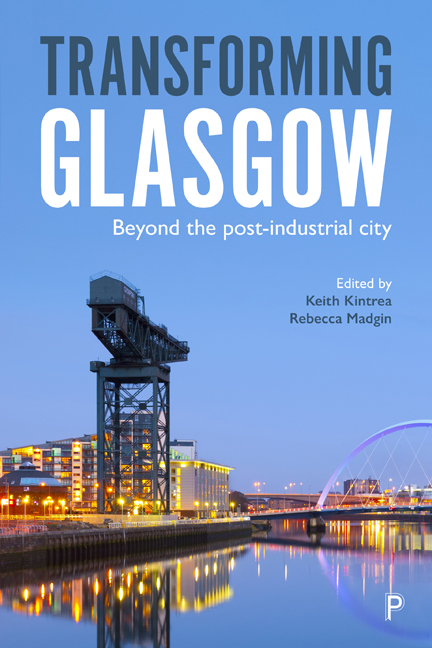Book contents
- Frontmatter
- Contents
- List of Maps, Tables, Figures and Boxes
- Notes on Contributors
- Acknowledgements
- Foreword
- Map
- Introduction: Transforming Post-Industrial Glasgow – Moving Beyond the Epic and the Toxic
- PART I
- PART II
- PART III
- Conclusion: Beyond the Post-Industrial – Narratives of Time and Place
- Index
2 - Escaping the Shadow of the Upas Tree
Published online by Cambridge University Press: 25 March 2021
- Frontmatter
- Contents
- List of Maps, Tables, Figures and Boxes
- Notes on Contributors
- Acknowledgements
- Foreword
- Map
- Introduction: Transforming Post-Industrial Glasgow – Moving Beyond the Epic and the Toxic
- PART I
- PART II
- PART III
- Conclusion: Beyond the Post-Industrial – Narratives of Time and Place
- Index
Summary
The upas tree
Glasgow is a city of economic scale, the economic heart of a region representing over a third of Scotland's economic output with over £40 billion gross value added and a third of its employment and population (Oxford Economics, 2014, p 7). It remains the fourth largest city in the UK behind London, Birmingham and Manchester (Centre for Cities, 2018, p 37) despite lower immigration levels and is amongst the top 40 largest urban centres in Europe.
In a powerful image Sydney Checkland captured the City of Glasgow's post-war predicament: under the shade of the Javan upas tree no other plant can grow. At the start of the 20th century the dominant role of heavy engineering – in the building of ships and locomotives –was Glasgow's economic upas tree. It was a position we would now talk of as a heavily concentrated industry cluster. In Checkland's analysis, so concentrated was Glasgow's engineering cluster that, unlike other UK cities, no other, more modern, industries could find room to grow. There was no space for the city economy to diversify (Checkland, 1976).
In the mid-1970s the outlook was indisputably grim; ‘creeping obsolescence’ as Checkland expressed it (Checkland, 1976, p 47). Over the following two decades, the oftentimes dramatic de-industrialisation of cities all across Northern Europe and the United States proved that dismal outlook broadly accurate. Glasgow's engineering cluster collapsed, unable to handle changing demands in its markets or to compete with lower labour costs in the emerging economies of South-East Asia. The situation in Glasgow's core city was exacerbated by policies aimed at tackling long-established social problems through slum clearance, the development of new towns and the relocation of business. All added to the de-industrialisation of the city. The challenge for national policy makers at the time was to cater for the ‘constructive contraction’ (Checkland, 1976, p 97) of Scotland's largest city. Would Glasgow be left on an inevitable track of managed decline or could a new economy emerge from the wreckage?
This chapter suggests that the economic prospects for Glasgow in the 21st century are much brighter, that the city is already well along the road to recovery and that diversification of the economic base was possible after all.
- Type
- Chapter
- Information
- Transforming GlasgowBeyond the Post-Industrial City, pp. 39 - 60Publisher: Bristol University PressPrint publication year: 2019



